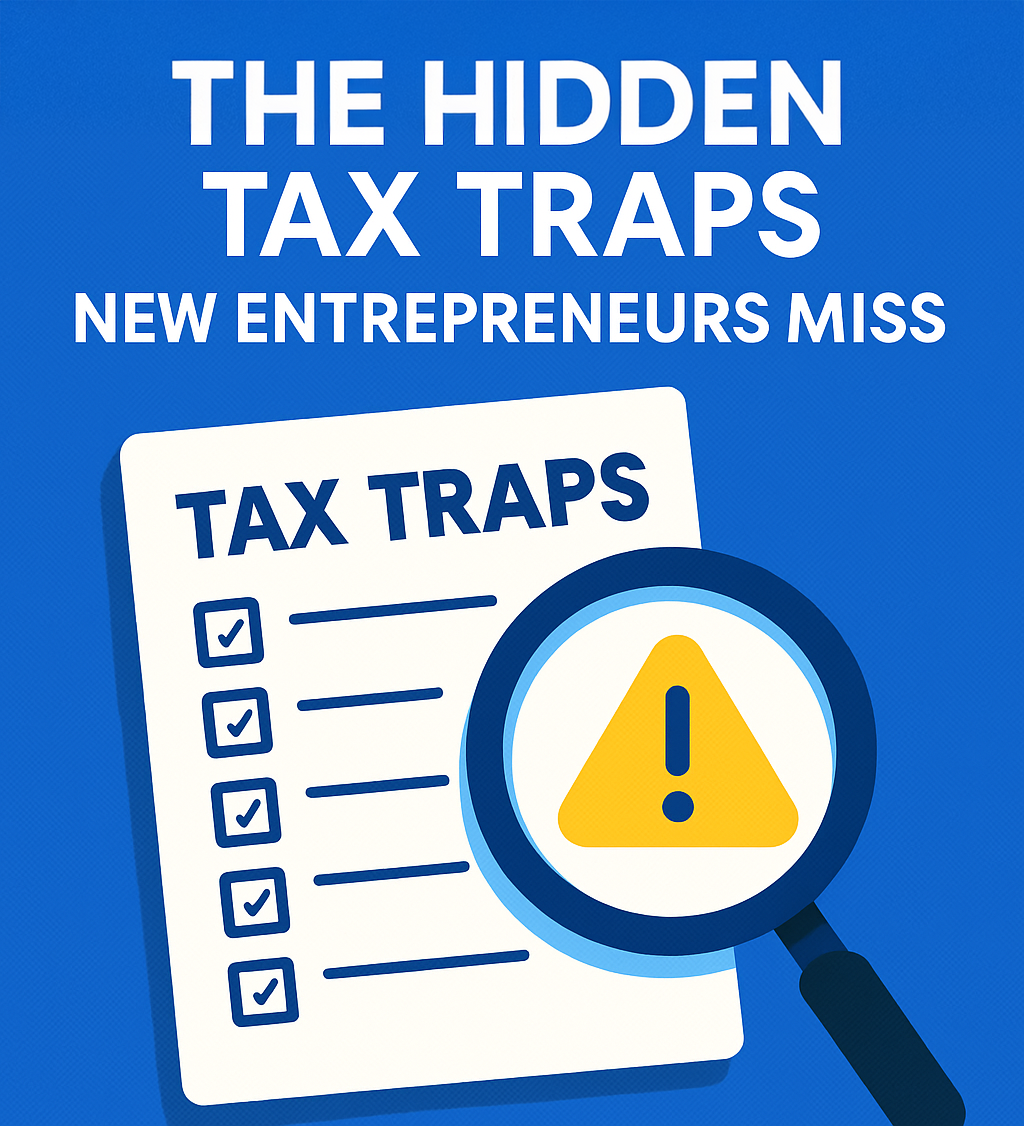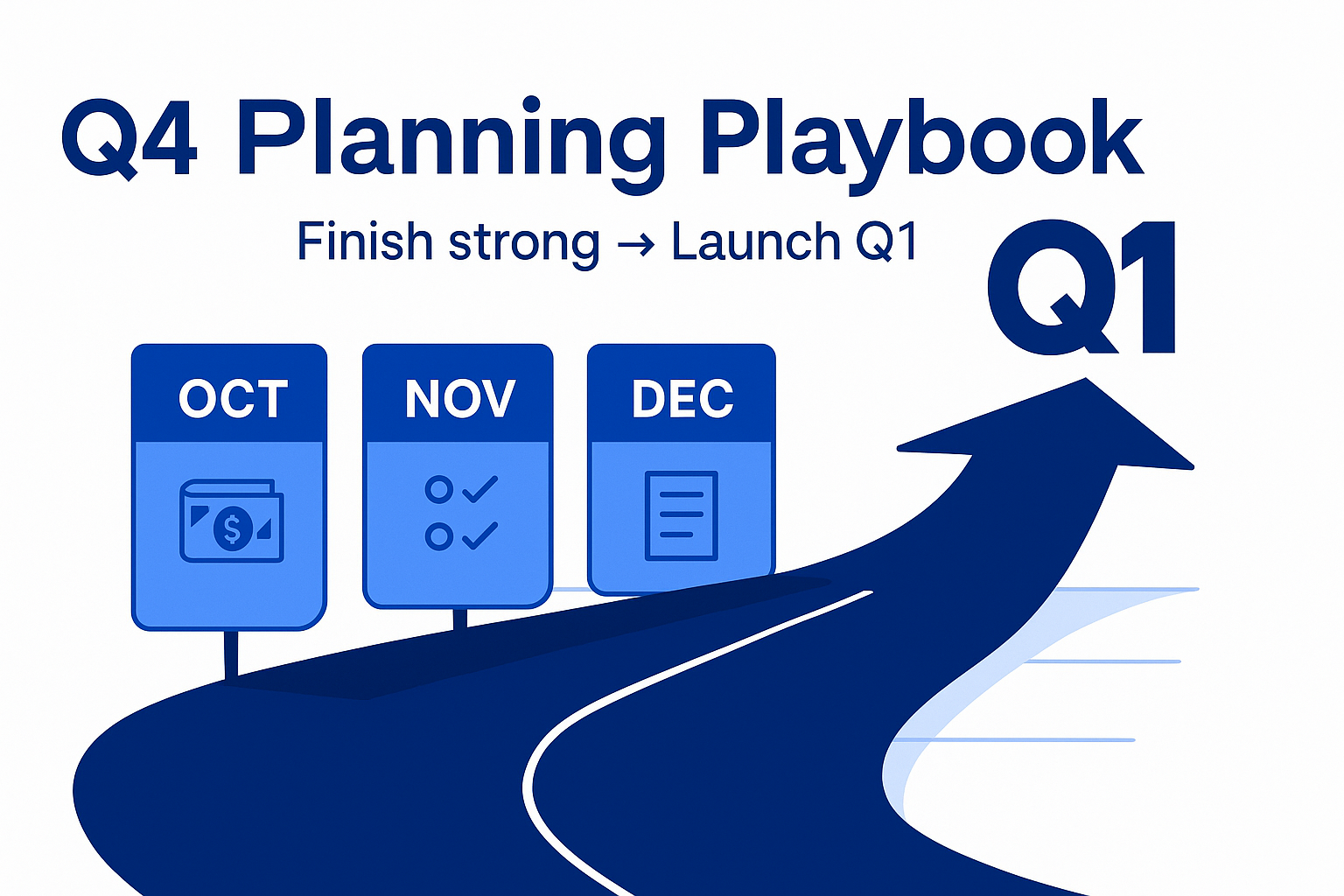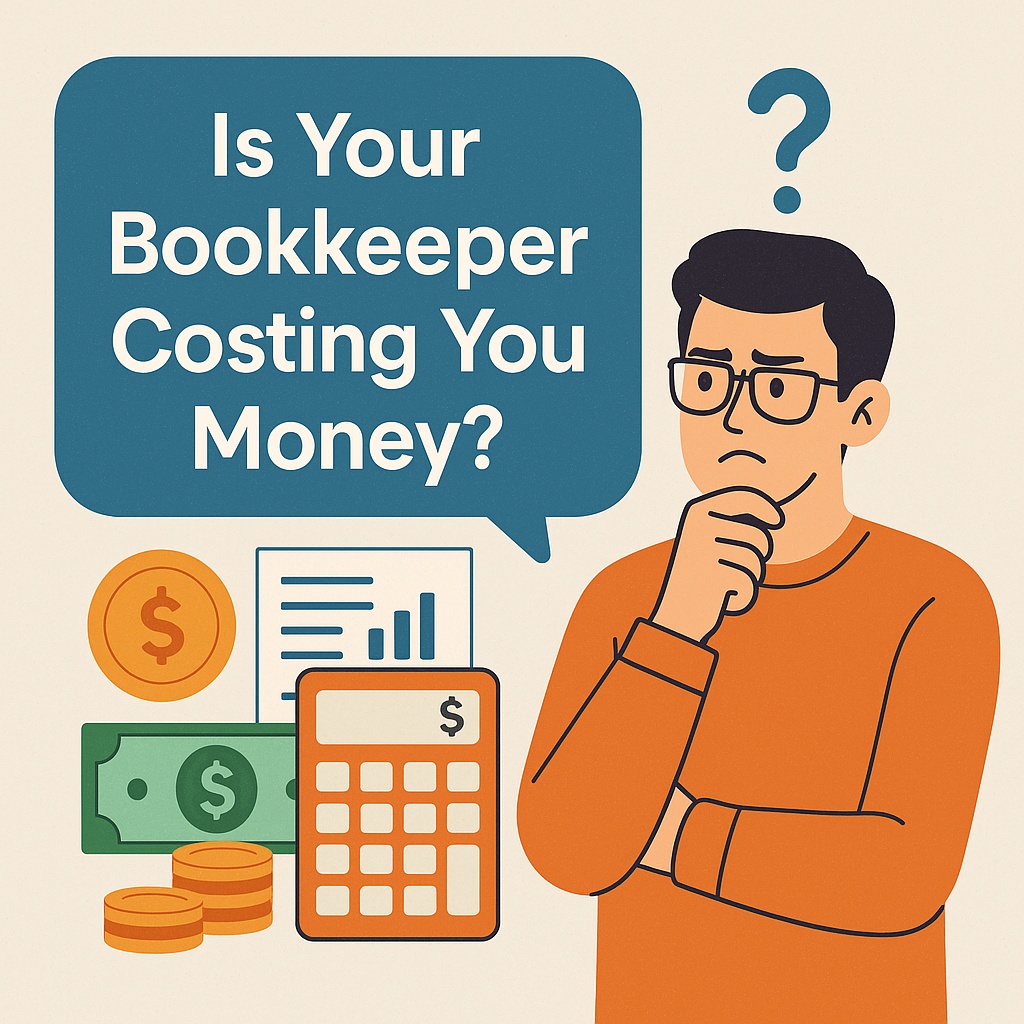
Avoid These 6 Tax Mistakes Most Entrepreneurs Make
You launched your idea, landed the first clients, and finally feel like the revenue engine is humming. Congratulations! That momentum is everything. Taxes, though, have a way of appearing in the least elegant moments: when paperwork is missing, a 1099 search turns into a treasure hunt, or an unexpected audit letter arrives.
This guide highlights six tax traps that entrepreneurs commonly miss, explains why they matter in plain language, and gives practical steps to close the gaps.
Why Taxes Hit Harder Than Expected
Most entrepreneurs expect taxes to be an annual box to tick. In reality, taxes are a continuous operating factor. Several factors amplify the impact of taxes on new businesses:
- Timing and cash flow: Taxes are not only about how much you owe; they’re about when the payments are due. Quarterly estimated tax payments, payroll deposits, and sales tax remittances create steady outflows that need to be planned for.
- Complex rules for small wins: A deduction that seems straightforward like a home office or equipment purchase, can come with specific rules that limit its benefit if you don’t meet IRS requirements.
- State and local complexity: Federal rules are only half the picture. Sales tax, state income tax, and local business filings vary widely across states and can surprise multistate sellers or remote teams.
- Documentation burden: The IRS cares about proof. Receipts, invoices, contracts, and mileage logs must match what you claim.
- Penalty and interest exposure: Missed deadlines and incomplete filings incur penalties that compound, making a small mistake expensive.
Collectively, these elements transform taxes from a paperwork chore into a continuous financial discipline. Treating tax planning as an ongoing part of finance can avoid surprises, keep cash flowing, and free you to focus on growth.
6 Common Tax Traps to Watch Out For
Below are six traps entrepreneurs encounter repeatedly. Each section explains the trap, why it matters, and what to do about it.
1. Missing Quarterly Estimated Payments
What it is:
If you expect to owe $1,000 or more on your federal return after withholding and credits, the IRS expects you to pay estimated taxes quarterly. States often have similar requirements.
Why it matters:
Skipping or underpaying estimated taxes generates penalties and interest. By the time you file, you may owe a large lump sum during a month with tight cash flow.
What to do:
- Run a simple projection of your year-to-date income and anticipated deductions.
- Use Form 1040-ES worksheets or your accounting software to calculate quarterly payments.
- Pay electronically via EFTPS or your state portal.
- If revenue is lumpy, estimate conservatively and adjust later. If you prefer not to guess, consider payrolling yourself a “reasonable salary” and withholding taxes to smooth the workload.
Pro tip: Automate quarterly payments and set calendar reminders. If cash is tight in a quarter, pay what you can and correct the remainder next quarter to reduce penalty exposure.
2. Misclassifying Contractors and Employees
What it is:
Misclassifying workers, labeling an employee as an independent contractor creates payroll tax and compliance risk.
Why it matters:
Worker classification affects who pays Social Security, Medicare, unemployment taxes, and whether the company must withhold income tax. Misclassification can trigger back payroll tax liabilities, penalties, and interest.
What to do:
- Use the IRS common-law test and the updated factors for gig economy and contractor relationships. The IRS provides guidance on behavioral control, financial control, and relationship type.
- Keep contracts, scope-of-work documents, and evidence of independent business operations (like your contractor’s invoices, business license, and multiple clients).
- When in doubt, treat the worker as an employee or consult a tax attorney.
- Run regular worker classification reviews, especially if roles or controls change.
Pro tip: If you rely on platforms (e.g., Upwork) or contractors overseas, document the engagement and payment terms to support classification decisions.
3. Improper Home Office or Mixed-Use Deductions
What it is:
The home-office deduction is valuable but requires strict “regular and exclusive use” rules. Many freelancers and remote founders assume they qualify automatically.
Why it matters:
Claiming a home-office deduction without meeting IRS criteria can trigger audits and disallowed deductions. On the flip side, a legal home-office deduction properly supported can reduce taxable income meaningfully for location-based solo professionals.
What to do:
- Confirm your workspace is used regularly and exclusively for business and is your principal place of business.
- Choose between the simplified method ($5 per square foot up to 300 sq ft) or the actual expense method (pro rata share of mortgage interest, utilities, insurance, repairs).
- Keep photos, floor plans, and a dated log of business activity in the space.
- If you share the workspace with personal use, avoid claiming the deduction.
Pro tip: For multi-location entrepreneurs (e.g., if you work on-site at clients), document how the home office remains your main business location.
4. Forgetting Sales Tax Nuances and Nexus Rules
What it is:
Sales tax is state-based; you might have a sales-tax collection obligation (nexus) when you sell into other states, even without a physical location.
Why it matters:
Marketplaces, vendor relationships, and online sales change nexus thresholds. Failure to register, collect, and remit sales tax in a state where you have nexus leads to back taxes, penalties, and interest.
What to do:
- Understand economic nexus thresholds (e.g., sales volume or number of transactions) for states where you sell.
- If you sell through marketplaces like Amazon or Etsy, determine marketplace facilitator rules: in many states, the marketplace collects and remits tax.
- Use a sales tax automation solution (TaxJar, Avalara) to monitor nexus triggers and file returns.
- Keep product/service taxability documentation because some services and digital goods have unique tax rules.
Pro tip: If you expand into new states, register proactively. A delayed registration increases your exposure to penalties and complicated filings.
5. Over-claiming Personal or Non-Deductible Expenses
What it is:
Small-business owners sometimes mix personal and business expenses, or claim deductions that aren’t allowed (e.g., commuting costs, certain club memberships).
Why it matters:
Personal expenses are not deductible, and claiming them can invite scrutiny. During audits, improperly mixed expenses are a common disallowance.
What to do:
- Use a separate business bank account and business credit card.
- Tag transactions as business or personal at the point of entry. If you accidentally pay personally, reimburse and document the transaction in your books.
- Familiarize yourself with common non-deductible items (personal commuting, personal travel, fines and penalties) and avoid claiming them.
- For mixed-use expenses (phone, internet), use a reasonable percentage based on documented business use.
Pro tip: At month-end, run a “personal expense check” in your bookkeeping system to spot and correct misclassified charges.
6. Ignoring Recordkeeping and Backup Documentation
What it is:
The IRS expects supporting documentation for deductions and credits. Digital and paper records should prove business purpose, amounts, dates, and recipients.
Why it matters:
Without substantiation, otherwise valid deductions can be disallowed, raising tax bills and penalties. Poor records make audits longer, more stressful, and more expensive.
What to do:
- Keep receipts, invoices, contracts, and mileage logs. Use cloud storage (organized folders) and name files logically (e.g., YYYY-MM-DD_vendor_invoice.pdf).
- Use accounting software that attaches receipts to transactions. Many apps allow you to snap receipt photos and auto-match them with expenses.
- Maintain payroll records, 1099-MISC/NEC documentation, and other tax filings for at least three years (seven for certain losses and issues).
Pro tip: Automate as much as possible. Receipt capture tools (Expensify, Hubdoc) paired with a clear folder structure save time and headaches.
Quarterly Tax Payments: Yes, You Probably Need Them
Many entrepreneurs treat taxes as an annual event and discover too late they should have been paying quarterly. Here’s how to know and how to act.
Who must pay estimated taxes?
- Sole proprietors, partners, and S-corp shareholders who expect to owe $1,000 or more after withholding.
- Corporations may have different estimated payment rules and should consult Form 1120 instructions.
How are payments timed?
Typically due: April 15, June 15, September 15, and January 15 of the following year (dates can shift with weekends/holidays). State schedules vary.
How to calculate
- Use Form 1040-ES worksheets, your prior year’s liability as a safe harbor, or current-year estimated income projections.
- Many founders use a 90-day lookback or a rolling forecast to estimate payments more accurately.
What if you underpay?
- The IRS may assess penalties for underpayment. You can reduce penalty risk by making a reasonable estimate and paying electronically.
- If income is unpredictable, consider a conservative estimate early in the year and adjust if revenue exceeds projections.
Clever approach
- Have your bookkeeper or outsourced accounting provider generate an “estimated tax” report at quarter start. They can calculate federal and state liabilities based on current books and anticipated seasonal shifts.
Writing Off Everything? Here’s the IRS Reality
Many entrepreneurs hear “deduct everything” and assume all business expenses are welcome. The IRS standard is different: expenses must be ordinary, necessary, and properly documented.
Ordinary and necessary
- Ordinary means common in your trade.
- Necessary means helpful and appropriate for your business.
Examples: advertising, professional services, software subscriptions, and equipment used predominantly for business typically qualify.
Common gray areas
- Meals: 50% deductible when business-related (some exceptions and temporary rules can change this percentage for certain periods).
- Entertainment: Generally non-deductible. Avoid combining entertainment with deductible meal claims unless clear business purpose is documented.
- Personal items: Not deductible even if partly used for work.
How to prove it
- Keep receipts, meeting notes, or calendar entries that show the business purpose.
- For mileage, maintain a log with date, miles, and purpose (apps like MileIQ help).
- For home office, use floor plans and photos, and choose an accounting method (simplified or actual) and be consistent.
Small-ticket mistakes that add up
- Misplaced receipts for thousands of dollars of small expenses.
- Failing to track dates and business purpose for meals or travel.
- Treating a personal event as a business gathering without documentation.
Practical defense
- If you rely on a fractional CFO or outsourced accounting, have a monthly cleanliness check where questionable items are flagged and resolved. That process reduces risk at filing time.
How a Fractional CFO Keeps You Audit-Proof
A fractional CFO brings leadership and process to finance without the fixed overhead of a full-time hire. For many founders, this role is the difference between being surprised by tax problems and having predictable, defensible tax positions.
What a fractional CFO does for tax health
- Planning and timing: Ensures estimated payments are scheduled and funded.
- Classification governance: Creates rules for categorizing expenses consistently across the accounting team.
- Documentation standards: Sets standards for storing receipts, contracts, and logs that hold up under review.
- Audit preparation: Prepares schedules and reconciliations that make the audit process smoother.
- Tax strategy alignment: Coordinates with your CPA to maximize credits, incentives, and lawful tax planning.
Real-world impact
- Reduced risk of penalties by having accurate payment and filing calendars.
- Fewer surprises at tax time due to monthly reconciliations.
- Faster responses to IRS notices because CFOs maintain organized schedules and backup files.
How CleverProfits helps
CleverProfits pairs bookkeeping, tax planning, and fractional CFO services. That combination means you get clean monthly books, an active tax calendar, and strategic conversations about entity decisions and deductions. Our clients often discover immediate improvements: fewer late filings, clearer records for tax professionals, and better tax outcomes.
How to Fix These Traps: A Practical Roadmap
If your books need work or if you want a preventative approach, follow this sequence:
- Run a Quick Health Check
- Pull a recent P&L, balance sheet, and cash report.
- Identify any large unreconciled items, unrecorded payments, or missing deposits.
- Document and Organize
- Gather receipts, contracts, and mileage logs for the last 12–24 months.
- Use standardized file names and cloud folders.
- Fix Classification Issues
- Reclassify personal vs business items. Mark personal reimbursements.
- Correct misclassified payroll, contractor, and tax accounts.
- Set Up Quarterly Tax Reminders
- Use calendar automation and electronic payment setups.
- If cash is unpredictable, build a tax reserve account (10–20% of net income).
- Automate Sales Tax and Nexus Monitoring
- Connect your sales channels to a sales tax service.
- Register proactively when thresholds approach.
- Adopt a Monthly Clean Routine
- Reconcile bank and credit accounts monthly.
- Review and clear unmatched transactions weekly.
- Engage a Fractional CFO or Outsourced Accounting Team
- If you lack in-house capacity, hire a team that offers bookkeeping, tax coordination, and CFO advisory.
- Establish SLAs: monthly close, tax calendar checks, and quarterly strategy meetings.
- Prepare Audit Packets
- Maintain a single folder per tax year with P&L, balance sheet, bank reconciliations, payroll, and key contracts.
FAQ’s
Q: What should I keep for receipts and records?
Keep invoices, receipts, bank statements, payroll records, 1099 and W-2 forms, contracts, and mileage logs. Generally retain documents for three years; keep some items longer for audits or loss claims.
Q: When should I hire a CPA vs a fractional CFO?
Hire a CPA for tax preparation and filing. Consider a fractional CFO when you need strategy, forecasting, and process improvements that reduce tax risk and support scaling.
Q: Can I fix past tax mistakes on my own?
You can file amended returns for many past errors. For payroll or contractor misclassification, professional assistance is recommended because these areas can generate downstream liabilities.
Q: How do I know if I need estimated taxes?
If you expect to owe $1,000 or more after withholding and credits, estimated payments are likely required. Use Form 1040-ES or your accounting provider’s estimate tool.
Q: Should I use accounting software or spreadsheets?
Accounting software (QuickBooks Online, Xero, etc.) is better for scale, automation, and audit readiness. Spreadsheets may work for micro-businesses but become risky as transactions grow.
Final Thoughts: Tax Planning is Financial Planning
Taxes are not an obstacle to growth; they are a structural part of building a healthy business. Early attention to classification, documentation, and payment timing will save money and stress over the long term. When you pair clean books with strategic tax planning and fractional CFO guidance, you convert tax obligations into financial advantage.
If you’d like help auditing your current setup, reconciling past records, or building a tax calendar that keeps your business on track, CleverProfits offers integrated bookkeeping, tax planning, and fractional CFO support for U.S.-based entrepreneurs. Book a call with the team to walk through your specifics and download the Tax Trap Checklist to get started.
Book a discovery call with CleverProfits today to see how we can clear all your tax traps.
The Clever Writing Team
The CleverProfits writing team includes various team members in Advisory, Financial Strategy, Tax, and Leadership. Our goal is to provide relevant and easy-to-understand financial content to help founders and business leaders reach their true potential.






